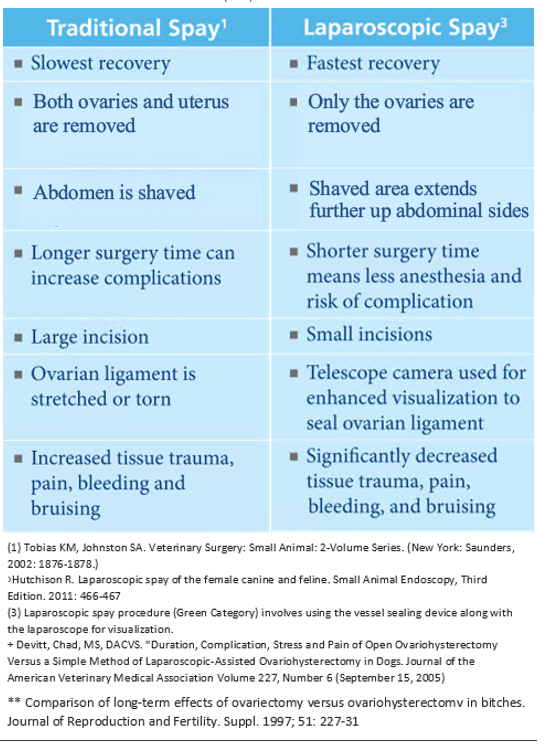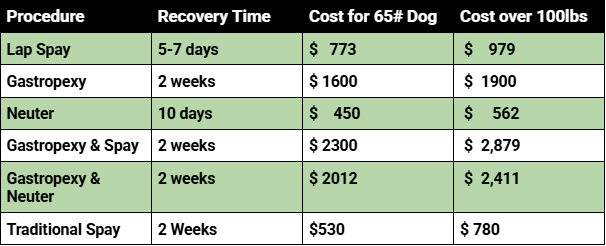Smalll Incisions, Big Benefits:
Laparoscopic Spays & Gastropexy
At Bishop Ranch Veterinary Center & Urgent Care, we believe every pet deserves access to the most advanced, minimally invasive surgical options for their health and well-being. Dr. Stefanie Wong and Dr. Bari Cappelletti are proud to offer laparoscopic spay procedures for dogs—a cutting-edge technique that reduces pain, speeds recovery, and minimizes tissue trauma compared to traditional surgery.
What is a Canine Laparoscopic Spay?
A laparoscopic spay—also called an ovariectomy—is a minimally invasive procedure that removes the ovaries through one or two small incisions.
How does a Laparoscopic Spay Work?
During the procedure, a small keyhole incision is made. A camera provides a magnified view of the ovarian ligament and blood vessels, allowing for careful cauterization (sealing) and cutting. Unlike a traditional spay, the ovarian ligament does not need to be torn—one of the most painful parts of the surgery. The uterus is not removed, which decreases tension and trauma.
Because of the improved precision and significantly smaller incision, there is typically less bleeding, fewer complications, shorter anesthesia time, and a recovery period that is about half the time of a traditional spay.
These advantages make laparoscopic spays a safer, more comfortable, and faster-healing option for your dog.
Benefits of a Laparoscopic Spay
Compared to a traditional spay, a laparoscopic spay offers many advantages that improve your dog’s comfort and recovery:
Key Advantages:
Smaller incisions – fewer stitches and less tissue disruption
Less pain – reduced discomfort during healing
Quicker recovery – most dogs return to normal activity in about 7 days (versus 14 with a traditional spay)
Minimal shaving compared to a traditional spay
Less trauma, bleeding, and bruising
Additional Surgical Benefits:
Better visibility for the surgeon – magnified cameras improve precision and reduce complications
Safer vessel sealing – specialized devices seal blood vessels before cutting, minimizing bleeding risks
Gentler technique – the ovarian ligament is carefully cut and cauterized rather than torn
Less invasive approach – only the ovaries are removed (ovariectomy), which has all the same benefits as a full spay but with less surgical trauma
Faster anesthesia recovery – your dog can wake up and return home sooner
What is a Canine Gastropexy by Laparoscopy?
A laparoscopic gastropexy is a preventive surgical procedure that helps protect large and deep-chested dogs from a life-threatening condition called gastric dilatation-volvulus (GDV), or “bloat.” In GDV, the stomach twists on itself, cutting off blood supply and trapping gas—an emergency that requires immediate surgery.
During a laparoscopic gastropexy, the surgeon uses small incisions, a camera, and specialized instruments to secure the stomach wall to the inside of the abdomen. This prevents the stomach from twisting in the future, dramatically reducing the risk of GDV.
This procedure is often performed at the same time as a spay or neuter for at-risk breeds, including:
- Great Danes
- German Shepherds
- Labrador Retrievers
- Doodles
- Weimaraners
- Standard Poodles
- Mastiffs
- Other large or giant breeds
By combining gastropexy with other procedures, your dog can have a safer, minimally invasive surgery with a faster recovery while reducing the risk of a life-threatening emergency in the future.


A 2005 study published in the Journal of the Veterinary Medical Association found that laparoscopic spays for dogs caused less surgical stress and up to 65% less post-operative pain compared to traditional “open” spays.
For large or deep-chested breeds, a laparoscopic gastropexy can be performed during a lap spay to prevent life-threatening gastric torsion (bloat).
The use of laparoscopic procedures in veterinary medicine is growing rapidly. At Bishop Ranch Veterinary Center, we also offer:
Laparoscopic liver biopsies – the preferred method for obtaining high-quality liver samples
Cryptorchid (intra-abdominal) neuters – performed laparoscopically for a minimally invasive approach
Is Your Dog a Good Candidate for a Laparoscopic Spay?
In general, laparoscopic procedures are recommended for dogs who meet the following criteria:
Age: between 6 months and 4 years
Weight: typically 15–20 pounds or more (though exceptions may be made)
Because the instruments are introduced through small portals and the abdomen is inflated with CO₂ to create working space, very small dogs can present challenges for this technique. Your veterinarian will evaluate your dog to determine if a laparoscopic approach is appropriate.
Cost of Laparoscopic Procedures
The cost of a laparoscopic procedure depends on your dog’s age, weight, and the specific procedure being performed. Because laparoscopic surgery uses specialized equipment and techniques, it typically costs 30–40% more than a traditional “open” spay or neuter.
If additional procedures, such as a prophylactic gastropexy, are performed at the same time as a spay, the overall cost difference becomes relatively smaller.
A full treatment plan and personalized cost estimate will be provided at the time of scheduling so you know exactly what to expect.
Estimated Procedure Costs:

Special Offer:
Schedule your dog’s procedure before 12/31/2025 and mention this webpage to receive $150 off either a Laparoscopic Gastropexy or Laparoscopic Spay Procedure.
How to Schedule Your Dog for a Laparoscopic Procedure
To provide your dog with the safest and most comfortable surgical experience, please contact us by calling or texting 925-866-8387 to schedule a consultation.
If your dog has had a veterinarian’s examination within the last 12 months, we can coordinate the procedure directly.
If it has been over a year since your dog’s last visit or you are new to our hospital, an examination will be required before scheduling the procedure.
Surgeries are available Monday through Thursday, and our team will provide a personalized estimate tailored to your dog’s specific needs. We are currently booking procedures 4 to 8 weeks in advance, so we encourage scheduling as early as possible!








